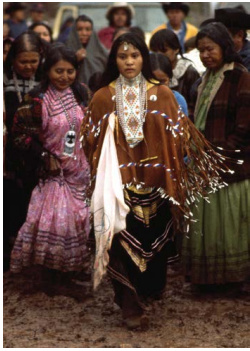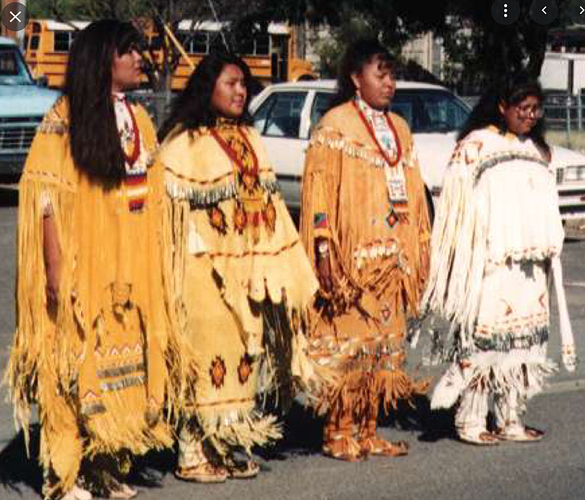which is why i think she ought to take a DNA test and make the results public
also, you grow up believing what adults tell you,so some uncle may have told her a story about the family, you don’t know
try finding Rumble on PBS passport
yes, but if you claim a certain tribe, the you ought to have seen at some point in your childhood the way everyone brings out their special clothes for ceremony. That was a pastiche of indigenous clothing tropes - all plains indians, I think.
The Christian schools did indeed rob children and families of their liberty and culture, and erasing their language and traditions was a crime, but I’ve never seen a local tribal member here sporting big concha belts or turquoise jewelry, because they have dress and ornament of their own to wear and display their identity with
I have totally seen lots of pix like that from the 60s. Lots and lots. And not just random pix but of people I know
just wanted to repost a story about Brando getting arrested alongside Indigenous protestors. He definitely was on the right side.
This blog post explains DNA testing for Native American heritage or Indigenous America. Indigenous DNA is picked up in those tests. However, from that article,
Does Ancestry DNA Test For Native American? - Who are You Made Of?
Additionally, there are no Native American tribes in the United States (as of 2021) that accept a DNA test as proof for membership.
If someone wants to claim membership in any tribes in the U.S., a paper trail is required.
I think it is a safe bet that Sacheen Littlefeather did not do the research nor submit the required paperwork for membership in either tribe.
She did take a DNA test:
As to Sacheen Littlefeather… I really don’t care. There’s more important things to be concerned about for me. Let the poor woman rest in peace.
If by “are part of a community” you mean “are entitled by their ancestry to membership in a federally recognized tribe” – then, no, it’s not always that easy to demonstrate.
For a long time the unofficial (and later official) policy of the US Government aimed at assimilating Native Americans into “white” society and breaking up tribal lands. The Indian Reorganization Act of 1934 restored the status of some tribal lands, but also facilitated the termination of scores of federally recognized tribes.
The history is long and complicated, but the result is that many people of Native American ancestry were separated from their tribes and lands. Many tribes were disestablished, although some have been restored. The result is that tribal membership is often difficult to prove.
For example, here in the Tucson section of the US-Mexico border it is often important to prove that someone is a member of the Pasqua Yaqui tribe for purposes of establishing their right to cross the border for religious or other reasons. The process for doing so has changed over the years, but it’s not that easy. Particularly if you don’t have good records and enough living relatives to back up your claims.
To me, her outfit looks similar to the buckskin dresses worn by White Mountain Apache girls at their “coming of age” ceremony (called the “Sunrise Ceremony” or “Sunrise Dance Ceremony”). It’s different, of course, but looks sort of like a more tailored version of that traditional dress. Here are a couple of pictures of Sunrise Ceremony dresses:

[Note: Don’t get me wrong… As I said above, I have reason to doubt that she was a member of the White Mountain Apache Tribe in the 1970s and, in the absence of proof that she was, I can easily accept that she knowingly misrepresented herself. (Or perhaps unknowingly, although that seems a stretch.) Here I’m just remarking on her dress, not her status.]
non-indigenous find aspects of Navajo and Hopi dress and ornament appealing, I can see why, but I wonder how Navajo and Hopi feel about it. Not rhetorical. In NM and AZ there are native traditional jewelry makers who are more than happy to sell to anyone.
as I said, general plains dress - but it seemed costume-y to me
There are gatherings and tribal competitions all over the west where the tribes compete in many dress, dance and athletics - and there’s just as much controversy within the different communities as to what is authentic and how much to ‘share’ with whites
Thank you for posting. Oppressed communities get angry when someone claims something they aren’t. There is a difference between DNA and being raised inside your community. But - she does have indigenous ancestry, she wasn’t lying. She never claimed to be oppressed as a tribal member.
It was a mistake to try and connect to an audience that way, but that makes her someone who didn’t go about garnering support the right way, not a liar and a cheat.
And it’s a big deal to the Cherokee, because they’re trying to strike people off their rolls all the time. People who really are tribal members. There is also a controversy over the inclusion (or not) of black descendants of the slaves they brought with them when they were forcibly removed from their homeland.
Checking-In Halfway
family connections to the White Mountain Apache or Yaqui tribes.
Obviously, she was Carlos Castanada.
Anyway, so Brando was fooled? I know he wasn’t a fan of awards for actors, but… I’ve only heard “she accepted an award”. What did Brando do?
That was how it hit me too. I remember her going onto the stage at the Awards, but I only heard marginally about Brando.
Now, I’m curious about why her, even if Brando was, like, concerned about Indian rights or something. And how her.
Hey, I’d like you to refuse an Academy Award for me tonight. I feel so passionate about that
Pacing yourself also has its merits, LGB. A lot of merit and it seems you did it well.
Although Janis missed the current shitshow.
FWIW, historian James Loewen wrote (sorry, don’t remember which book) that, after the end of the Indian Wars and during the nadir of Black/White relations in the early 20th century, a lot of Black ancestors in White families were rebranded as Native American.
Subsequent generations had no reason to disbelieve those stories. Not before widely available DNA testing, anyway.
Keeler, who wrote the SF Chronicle article, researched “Littlefeather’s” ancestry back four generations or so, and there were no Amerindians to be found. Nada. Null. Zero. Her father was Mexican, so, yes, there are undoubtedly Indians to be found somewhere in the family, but are we really going to apply the one-drop rule whenever an oppressed people are involved?
I mean, I have a Laplander in my family. We have no documentation, because, as an historically oppressed minority in Scandinavia, no one wanted to acknowledge it. Am I a Laplander (Sami)? My share of oppressed ethnic DNA is apparently greater than “Littlefeather’s,” so I must be, right?
She made shit up. She was as Indian as Rachel Dolezal is Black. She made up an identity that she found more glamorous, and believed would help her break into show business–remember, the late-60s was a great time to make this claim.
She made up shit about her family, hurtful shit. She stole things that did not belong to her, making the safe bet that no one would dare question her. She was mentally ill? That’s genuinely awful. However, as an adult she had an obligation to receive treatment.
She had options in life, and she chose to lie.
She grew up in Port Arthur TX, an oil town in Texas feeling like an outcast, knew she had to escape to make her mark so San Francisco, “Peace, love and rock 'n roll” in the Sixties was it.
Pretty good, I think. At least as far as the silver jewelry business goes. I think that has always been a trade item, as well as personal decoration and a wealth repository.
Silversmithing isn’t really an ancient tradition with the Navajo, Hopi, or Zuni. They took it up in the mid-1800s after European contact. I don’t recall if they even had a local source of silver in those days as most of their creations were from coins or other silver originally from European-American traders.
As for clothing, what we think of as traditional Navajo women’s clothing (the kind worn by all the grandmothers when I worked on the Navajo reservation in the 70s) isn’t really the historical clothing of the Navajo. The full, pleated fabric skirts and velveteen blouses were adapted from the clothing of non-native women in the 1800s, replacing the traditional deerskin and blanket dress.
Still, I admit I find it jarring when I see a non-Navajo woman in “traditional” Navajo women’s dress. Probably because that type of 19th century dress is no longer seen on non-native women and so has transitioned into a cultural item. And because the wearer’s intent usually strikes me as “Look, I’m dressed like a Navajo!”
But non-natives have been trading for, buying, and wearing Navajo and Hopi silver jewelry for a couple of centuries. So that doesn’t strike me in the same way.[1]
[1] Or maybe I’m blinded by personal interest. Almost 40 years ago I had a Hopi client who was the nephew of Victor Coochwytewa – a famous Hopi smith. Through the nephew I contacted Victor and arranged for him to make a gold wedding ring for my soon-to-be wife, using the overlay techniques he pioneered with Hopi silver jewelry. I had to provide the gold myself up front and then meet him in a parking lot in Flagstaff to pick it up – but it was worth it.
This is the issue with appropriating identity — people often end up reinforcing a wrong stereotype and that further cements it. Most of our ideas about what Native culture was like is based on plains cultures. It frustrates me because often I feel like it’s saying traditional Europeans make Matrioshka dolls, eat pasta with tomato sauce and wear lederhosen. The Wabanaki in Maine made things for the tourist trade in the early 1900s that were based on white people’s ideas of indians — ie they had the feathered headresses of plains tribes. It was like Swedes selling Eiffel Tower souvenirs.

